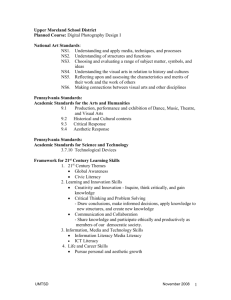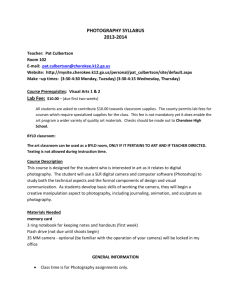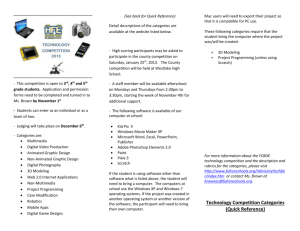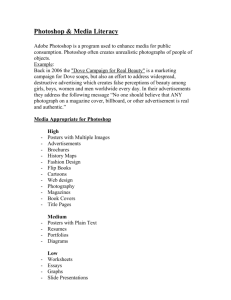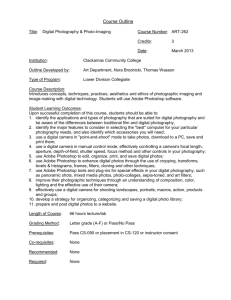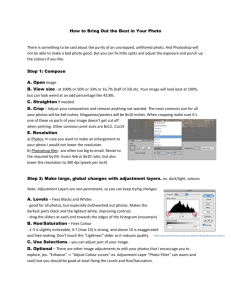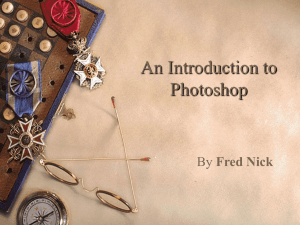Grade 11 Photography Exam - University College
advertisement
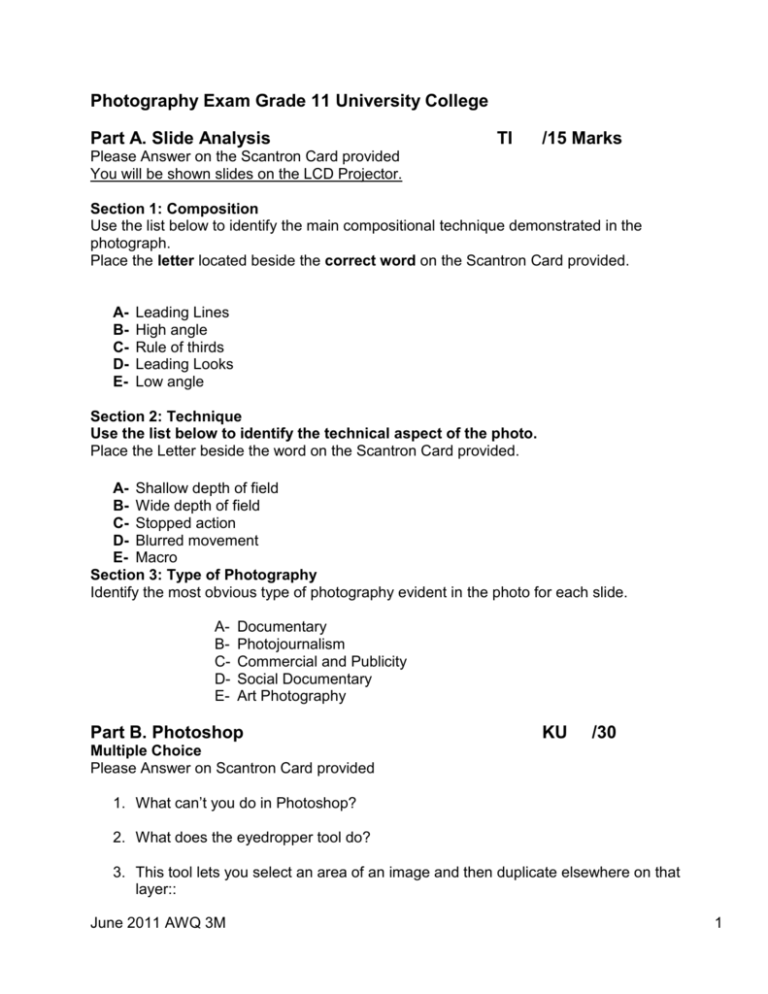
Photography Exam Grade 11 University College Part A. Slide Analysis TI /15 Marks Please Answer on the Scantron Card provided You will be shown slides on the LCD Projector. Section 1: Composition Use the list below to identify the main compositional technique demonstrated in the photograph. Place the letter located beside the correct word on the Scantron Card provided. ABCDE- Leading Lines High angle Rule of thirds Leading Looks Low angle Section 2: Technique Use the list below to identify the technical aspect of the photo. Place the Letter beside the word on the Scantron Card provided. A- Shallow depth of field B- Wide depth of field C- Stopped action D- Blurred movement E- Macro Section 3: Type of Photography Identify the most obvious type of photography evident in the photo for each slide. ABCDE- Documentary Photojournalism Commercial and Publicity Social Documentary Art Photography Part B. Photoshop KU /30 Multiple Choice Please Answer on Scantron Card provided 1. What can’t you do in Photoshop? 2. What does the eyedropper tool do? 3. This tool lets you select an area of an image and then duplicate elsewhere on that layer:: June 2011 AWQ 3M 1 4. How much chemical is required to mix with water for developer? 5. Which step in developing photos requires constant agitation 6. . This tool allows you to build up an image without effect corresponding images within the same document: 7. . To Deselect an image you press these buttons on the keyboard 8. By changing the % of_______, you can blend multiple layers with one another. 9. What are the 3 main chemicals used in processing bw prints? 10. What is the photographer’s purpose for making a test strip? 11. “Layers” in Photoshop are: 12. Which camera mode is used to best enhance textures? 13. ‘Levels” in Photoshop are: 14. Clicking and holding the mouse button on a toolbar icon does what? 15. What is the default file format generated by Photoshop and what versatile format must you change it to? Part C. Definitions KU /20 Group A: Terms Using the list of words provided and match each one to its A. B. C. D. E. Parallax error Depth of field SLR Film speed Focal length June 2011 AWQ 3M 2 Group B: Parts and their Function Using the list of camera/enlarger parts provided, match each one to ABCDE- Hot shoe Timer Lens Aperture dial Viewfinder Group C: Darkroom Using the list of words provided and match each one to its definition or purpose. ABCDE- Ph scale Agitation Filters Safelight Contact Print Group C: Photoshop Tools Using the list of words provided and match each one to its definition or purpose. ABCDE- Hue/Saturation Clone Tool Dodge Tool Marquee Quick Mask Part D. PHOTO CRITICISM (27 marks) 1. Complete the chart below for the slide shown K /8 Element K /8 TI /6 COMM /13 C /8 16 marks Choice and support for it F stop Shutter speed Angle of view Light angle Distance from subject Focal Point Main element of design Main Principle of design June 2011 AWQ 3M 3 2. Message/ Interpretation: TI /3 marks What is the photographer of this slide communicating to the viewer on a visual level and on an emotional/intellectual level? 3. Cultural Context TI /3 What connection to society or culture is the photographer making? What society and when? Do you think it would still appeal to people today? Explain why or why not. 4. Aesthetic Judgment COMM /5 What qualities make this photo valuable? __________________________________________________________ What might you change about this work, and why? __________________________________________________________ Have your opinions changed from your initial reaction? Explain how. ___________________________________________________________________________ _______________________________________________________________ Part E. Reflecting and Responding Reflecting on your work COMM /16 Response Advancements in technology and the use of Photoshop, has allowed photographers to manipulate images to suit their needs. Quite often, models and actors are “perfected” in Photoshop before their photo goes to print. Also, figures can be removed, and placed in different backgrounds to create a more “perfect shot”. June 2011 AWQ 3M 4

